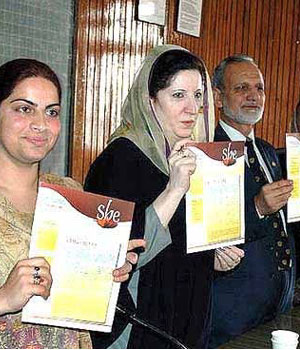
Vice-Chancellor of Kashmir University Abdul Wahid Qureishi (far right) and Editor-In-Chief of ‘She’ Magazine Saima Farhad (far left) at the launch of the magazine
The first magazine dedicated to women has been launched in Kashmir. Focusing on explosive topics such as dating, beauty, the increase in rates of breast cancer amongst women and the difficulties surrounding abortion, ‘She’ has broken new grounds and reflects an ongoing change amongst educated Muslim women in Kashmir.
“More than ever, women are confronted with issues that have changed their role in society. These role changes have brought about a new set of problems for women today. Previously, it was understood that a woman would stay at home and look after her family. Today, because of economic reasons, it has become a necessity for a woman to work to financially contribute to her family.”
The magazine is edited by Sheeba Masoodi, US-educated wife of Mirwaiz Umar Farooq, the chairman of the Hurriyat Conference separatist group and spiritual leader for millions of Muslims in the disputed region.
An investigation into the rules of dating in the conservative province, entitled “Dating and Teenagers” quotes several female students singing the praises of female-male relations. “Being in love is entertaining. Your boyfriend buys you chocolates and you get to tell all your friends,” one young girl is reported as saying. However, the article warns that love does not come without its dangers including “emotional and physical pain when couples break-up”.
The honest discussion of an-otherwise taboo subject was condemned by some women in Kashmir. Nusrat Andrabi, a former director of the Women College in Srinagar said, “Dating is not part of our culture,” adding that she planned to write to the editor and call for different topics to be reviewed in the magazine.
The daughter of a Kashmiri doctor and settled in New York, 27-year old Sheeba married Mirwaiz in 2001 through an arranged marriage, like many others in India. Combining modernity with tradition, she is well aware of her rights but wears the hijab (Islamic veil worn by Muslim women) in public and refuses to have her picture taken, mindful of her family’s religious standing.
Sheeba is joined on the editorial board by Zulfiqara Mantoo, Rabia Noor and Saima Farhad who indicated the magazine would focus solely on women’s issues and not discuss politics or religion.
Hardliners and several Islamist militant groups criticized the magazine and attacked it for encouraging the moral decay of Kashmiri women.
However, in recent years, couples can be seen walking together around public parks, or sitting in restaurants and internet cafes. Beauty parlors and boutiques have also opened in the restive province. Women in Kashmir can be found working with men in banks, newspapers, radio and TV, without wearing a veil.
Meanwhile, ‘She’ has attracted strong support from young women, who say there is an urgent need for a platform in which to discuss their social, personal and professional problems. “I am so excited about reading the first issue. It discusses modern life instead of religion,” said Rehana, a female university student.
The magazine has also been welcomed in some male circles, with Dr. Abdul Wahid Qureishi, vice-chancellor of Kashmir University indicating, “High dowry demands, domestic violence and suicide rates amongst women are rising. The launch of ‘She’ is a positive development. It should focus on the problems faced by women in Kashmir.”
